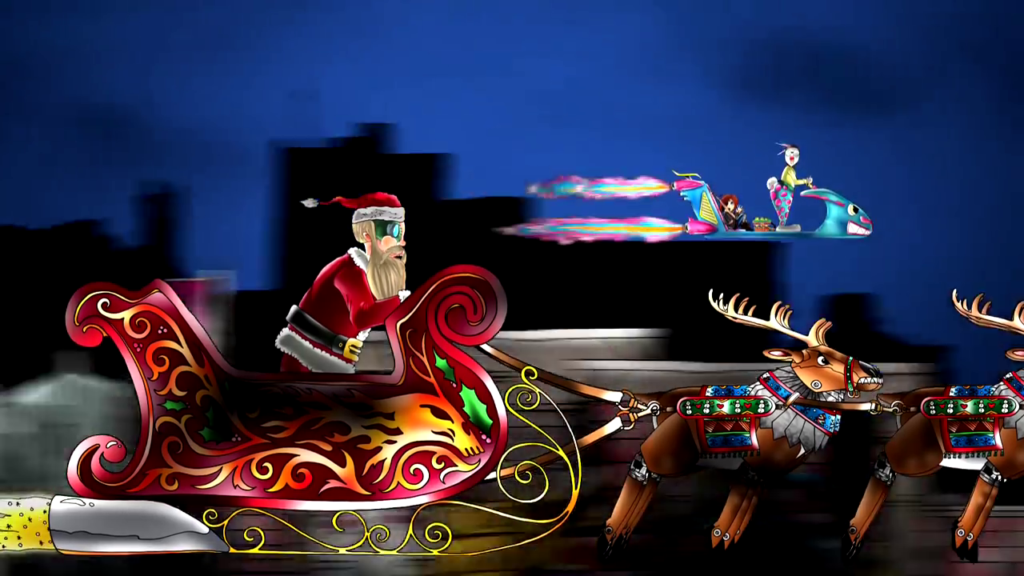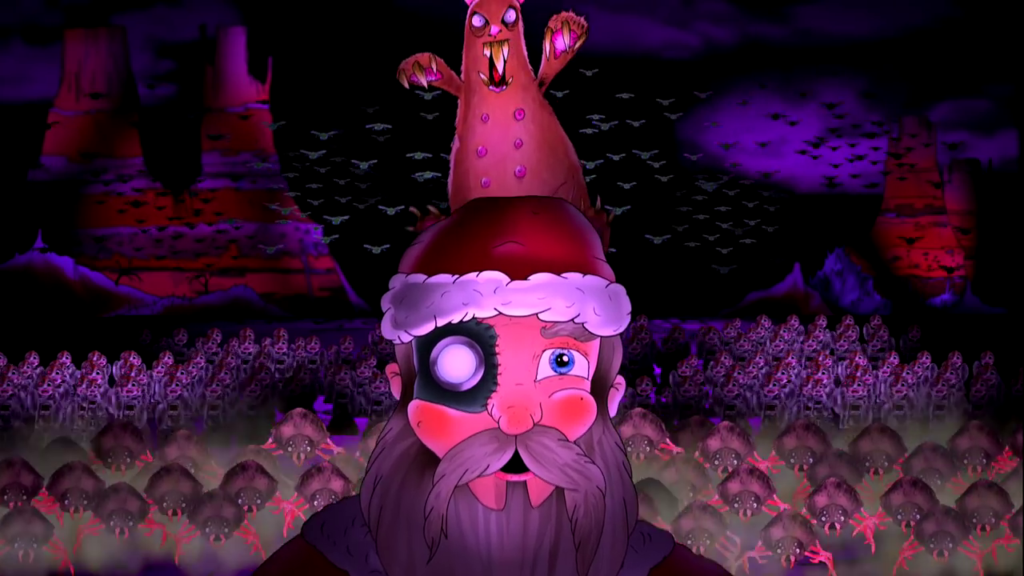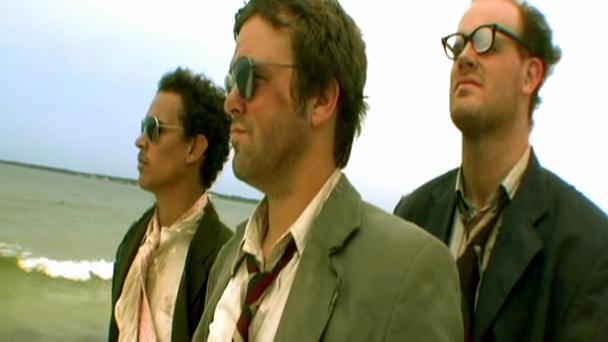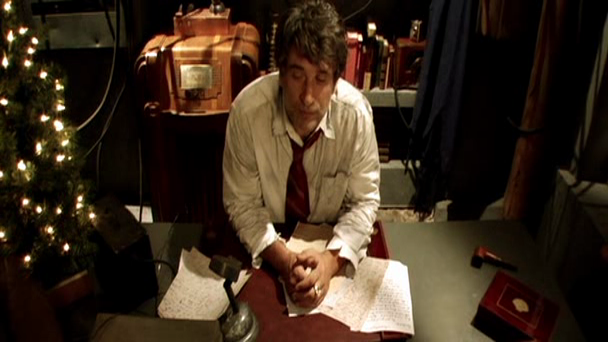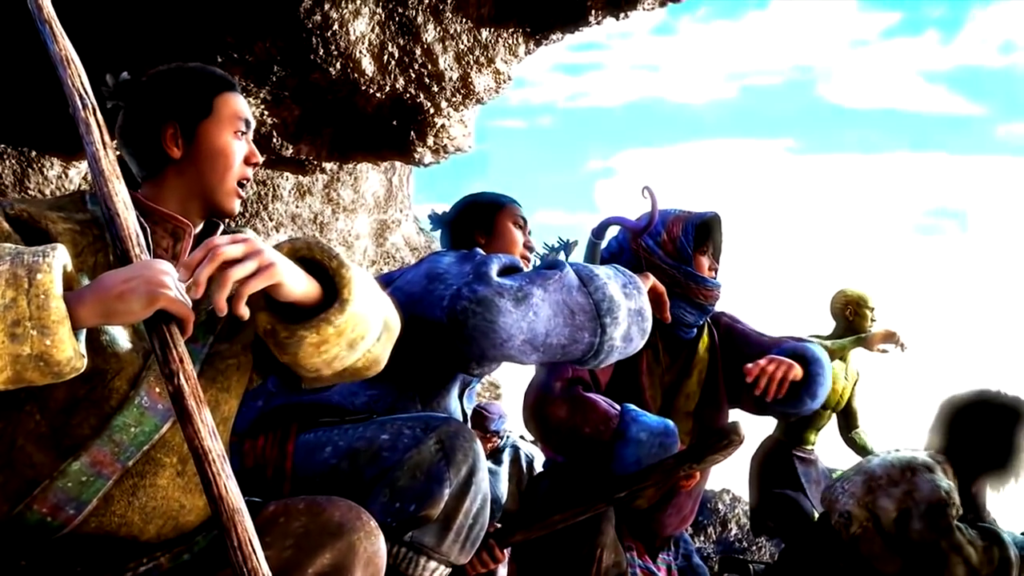-
#434 – Infinite Santa 8000 (2013)
Infinite Santa 8000 (2013)
Film review #434
Director: Michael Neel
SYNOPSIS: A thousand years after humanity has destroyed itself, all that remains in the world is a host of mutants, robots and monsters…and Santa Claus, who has to survive by killing these monsters. When evil scientist Dr. Shackleton comes for Martha, the little girl that Santa has been taking care of, he sets on a rescue mission and to blow up any creature or killer robot that gets in his way.
THOUGHTS/ANALYSIS: Infinite Santa 8000 is a post-apocalyptic Christmas action film (I think that’s the best way to describe it). The setting is a post-apocalyptic world a thousand years after humanity has destroyed itself, leaving the Earth populated by mutants, monsters and killer robots of all persuasions. One survivor of the old world though, is none other than Satna Claus, who we see in the opening scenes in an arena fighting to the death against a creature to earn some scraps of meat. Victorious, he returns to the “North Pole ranch” to et with Martha: a young girl he rescued at some point. However, the evil scientist Dr. Shackleton sends the Easter Bunny to kidnap Martha and return her to him, and with that begins Santa’s crusade against the horrors the post-apocalyptic wasteland. The story of the film is very simple: Santa stopping Dr. Shackleton and dismembering everything in his way. The appeal of the film is not in its compelling narrative, but in the sheer absurdity of its concept of having Santa murder everything and anything in a post-apocalyptic wasteland. Nevertheless, the film does take itself fairly seriously, and perhaps surprisingly does a good job of depicting a bleak and hopeless world and having Santa being the only one with any sense of hope and joy. Nevertheless, there’s still plenty of over-the-top fights and action scenes that maintain a sense of momentum throughout the film. I mean, who wouldn’t want to watch a cyborg Santa chase down and fight a mutant Easter bunny? If I had to identify a weak point, I would probably cite the dialogue, as it often lacks either the energy, or the humour to make a huge impact. There’s times when you expect Santa to deliver a Christmas-themed one-liner before he dismembers somebody, but what he comes out with always feels like it comes up a little short on having the necessary impact.
The main character of Santa Claus probably needs no introduction: He’s the same bringer of festivities you know, except he is mostly a cyborg now and hacks monsters to pieces. There’s enough of a twist on the familiar concepts as well, such as the North Pole being a ranch out in the wasteland, and his reindeer being jet-boosted robots themselves (Also Rudolph is named Randolph in this version for some reason). Martha plays a familiar role of a young, innocent child that serves as the last vestige of humanity in the post-apocalyptic wasteland, and also the means for the main character to regain their humanity in some way. Given that the main character is the literal embodiment of joy and goodwill, the whole plot between Martha and Santa is fairly predictable. Nevertheless, it is still executed quite well, as we see how Santa lived through the end of the world and thought all the joy and good from the world had gone until he met her. The character designs across the board are quite intricate and full of detail, showing off the horrific mutations and augmentations that the creatures of this world have ended up with, which gives the film a definite visual appeal.
The animation and design of this film are definitely worth mentioning. As mentioned, the character designs are intricate and a decent amount of detail, which emphasises the grotesque, inhuman mutations of the creatures that roam the world. Most of the characters are still images that over across the screen in various ways to give the illusion of movement, perhaps similar to what you would see in South Park, for example. However, there is some very clever techniques used to make them move and give them a definite sense of momentum. For example, the chase between Santa and the Easter bunny maintains a serious sense of high speed and energy. In the slower scenes however, the limitations of the animation are more apparent. Fortunately, the film knows to focus on the action, and that’s what you’ll remember coming away from it. The heavy metal soundtrack also gives the film a similar high energy, and everything seems to blend together pretty well. Overall, Infinite Santa 8000 fulfils the ridiculous concept it proposes, while also clearly being a labour of love that has plenty of effort and consideration put in to make it a coherent and visually appealing experience. It has a number of shortcomings, but it certainly exceeds any expectations you may have going into it.
-
#359 – The Beach Party at the Threshold of Hell (2006)
The Beach Party at the Threshold of Hell (2006)
Film review #359
Director: Jonny Gillette, Kevin Wheatley
SYNOPSIS: Twenty years after nuclear war has destroyed the U.S., the radiation levels outside have dropped to a safe level, and people can venture outside into what is left of the world. Tex Kennedy is on a quest with his two humanoid robots Quincy and Yul to retrieve the man destined to be the new King of America, but to do so they must cross into Hell (which is somewhere on the Florida coast apparently) to find him and face all the evils within…
THOUGHTS/ANALYSIS: The Beach Party at the Threshold of Hell is a 2006 independent post-apocalypse film. The film begins describing the setting of the film, with a mixture of narration and footage. In the year 2074, a nuclear war has rendered the surface of the United States uninhabitable, leaving all survivors stuck in underground bunkers. Twenty years later, the radiation has declined enough so that humans can venture outside. Tex Kennedy, having left his bunker, is now on a quest to follow the guidance of Clark Remington, a man who broadcast on the radio to the bunkers, who proclaimed his nephew Benny the new King of America, and Kennedy is on a mission to retrieve him and in the process become Vice-King. The story is told in a number of ways: through narration, through a kind of mock-documentary, with presenters/authors telling the history of what happened, and through the action itself. All these different methods of storytelling are constantly overlapping and cutting away from each other, which makes the film honestly feel like a bit of a mess. Maybe that’s because the film isn’t really sure about how to portray itself: I think it’s supposed to be a comedy, but there’s an awful lot of backstory and flashbacks that really makes a considerable effort to flesh out the story and the setting, but ultimately doesn’t really matter. For a film that is only ninety minutes long, it spends a lot of time explaining what is going on, and seemingly trying to justify itself by inventing this grand narrative that doesn’t really go anywhere, leading to a but of a confusing mess. I could forgive it if the film identified itself as more of a comedy film that treated the backstory as secondary, but the fact that it spends so much time setting up this world doesn’t really allow that as an excuse.
So Ted and his robot security guards arrive at the “Threshold of Hell”, where Benny Remington is hiding in a bunker, and they have to get him out and journey to a radio tower and broadcast their message to the entire country. However, the threshold of Hell is full of crazed characters that are out to stop them. These characters all have their own personality, but there’s just so many of them they only get a small amount of screen time each. and there’s not much time to really develop their roles. There’s Clark Remington’s son, calling himself Mr. Jackie, who wants to become the king himself after his Father disowned him for basically being a sociopath, and his whole gang, including his sadistic lieutenant. There’s also Yorick Schlatz, who is a cult leader who hosts the beach party at the threshold of hell and who also possess satanic powers that keeps the partygoers immortal and unaffected by the radiation for the past twenty years. Also Fidel Castro’s descendent Javier Castro shows up to create a dynamic with Tex, the descendent of President Kennedy…or he would do, if he stuck around longer. All these bizarre and nonsensical characters all have some potential to do some interesting things, but the film constantly over-explains everything and never lets the characters speak for themselves. Again, if the film is aiming to be a black comedy or focusing on dark humour, then it could have worked, but there’s just not enough focus on what it wants to be.
Being an independent film, you won’t be expecting any spectacular special effects or ambitious cinematography, and you won’t be surprised with what you get. The camera is all over the place and can barely frame a shot most of the time, the scenes that are filmed in front of a green screen are blindingly obvious, and the acting is pretty wooden throughout. One more surprising element in the film is that it is quite gory. Even though the blood and guts look obviously fake, it further still confuses the tone when it is trying to be funny and then someone’s organs get ripped out. There’s a scene in the middle of the film involved with a giant snake of some sort and the film instantly switches to a hand drawn animation sequence for about twenty seconds with no set-up or transition and it just feels like an acknowledgement that the film could not make this scene any other way, and just tacked in this sequence just to fill the gap. Overall, The Beach Party at the Threshold of Hell feels like it is trying to do far too much with far too little. It feels indecisive with regards to the tone of the film or what genre it is trying to establish itself within. Far too much time is spent describing characters and backstory instead of letting the film show it, and the constant interruption to the story to expand on these elements is distracting and makes retaining focus and interest in the film difficult. It has one or two laughs, but there’s nothing really worthwhile here.
Also, the film ends with the teasing words “end of part one”, which suggests more to come, but a sequel was never made, which is probably for the best.
-
#351 – 10000 Years Later (2015)
10000 Years Later (2015)
Film review #351
Director: Li Yi
SYNOPSIS: Ten thousand years after advanced civilisation was wiped out and the world reverted to a pre-technological state, Joma and Yalayam of the Ballad tribe are travelling the western region to tell the tale of the fall of civilisation. Unfortunately, Wugreb, who once tried to steal the ancient powers to rule the world, has returned, and Joma alongside her new friends must find a way to stop Wu before he releases the ancient civilisation’s power back onto the world, all controlled by him…
THOUGHTS/ANALYSIS: 10000 Years Later is a 2015 Chinese animated film. It is a mix of post-apocalypse, science-fiction and fantasy elements, as it is set (as the title suggests) 10000 years after civilisation suffered a catastrophe that sealed away all of its advanced technology and left the world in a pre-technological state. The world is now separated into various tribes, which include anthropomorphic animals and various mutations brought about by the catastrophe. Joma and Yalayam are from the Ballad tribe, who wander through the western region telling the story of the fall of the ancient civilisation to the other tribes. They also tell the story of Wugreb, who once tried to steal the ancient technology that is sealed away and rule the world with it, warning that anyone who tries to do the same will be met with the same fate. However, Wugreb (or Devil Wu, as he is also known) has returned, and is attempting to once again take the technology of the ancient civilisation for his own. The story relies a lot on this extensive world-building, and how the world has changed since the fall of civilisation as we know it. Sometimes it is easy to follow, but at some points it gets overly complicated, and for a film that is just over ninety minutes long, the explanations and exposition it gives do seem a little excessive. Nevertheless, it is an interesting world that is built, and the variety of locations and characters give it a unique sense of life and vibrancy. The people refer to famous people throughout history (Einstein, Beethoven etc.) as the “Gods” of the old world, and it is an interesting way to interpret history’s most pivotal figures. There are these odd scenes which play out quite nicely, but they are mostly used to explain the state of the world, and when the film returns to the main characters, they seem much less interesting.
Joma goes to see an oracle, who tells her that she is the only one who can stop Wu, and she must go to Kuger, the tomb where Wu was imprisoned, to stop him. Along the way Joma is joined by a cast of characters from different tribes who all inject their own personalities into the film. The film very much has a Lord of the Rings feel to it, with the group travelling to their destination to stop the oncoming evil, and all the perils that they encounter. But again, there’s a lot of backstory and exposition that disrupts the flow of the film, and you really have to focus and pay attention to follow what is going on. The characters on the whole, though, are distinct enough to be able to follow, but for all the explaining and exposition, don’t really do much, so it’s hard to get to know them as characters. At once point the film deals with the meeting of the Gods which I can’t really make sense of; and whether they are actual Gods or not is anyone’s guess. Joma as the main character is also a bit bland and uninteresting: even though she is marked as the chosen one, she doesn’t really have any defining traits or character defining moments that make her stand out, and she is often very passive to the events of the film. The ending of the film also does little to elucidate the significance of Joma’s role, and makes little sense. The designs of some of the villains, with their multiple faces or limbs and other bizarre features are both scary and creative, and the somewhat imperfect animation actually helps exemplify their grotesqueness.
This film is entirely CG animated, and for the most part it creates a world that has immense scale, colourful diversity and interesting locales. We see ruined versions of recognisable cities such as New York and Sydney, which add some interesting shots and perspective on the story. There are some moments when the animation gets a bit clunky, and facial expressions and movements sometimes look a little stifled or flat, but otherwise it doesn’t distract too much from the film. It’s not cutting edge in terms of its graphics, but it is passable for a kids film. Apart from the Lord of the Rings influence mentioned above, there is also a certain amount of ‘inspiration’ taken from the Marvel Avengers films. When I say inspiration, that often becomes blatant copying, such as the five stones that Joma carries containing seeds from across the western region clearly being based on the “infinity stones” in the Marvel universe, and there is a shot which copies exactly the iconic shot from the 2012 Avengers film of all the superheroes together for the first time on the streets of New York City. All this copying does cheapen the film’s overall image, but being a Chinese film, where these films would not have seen much of a release, the audience probably won’t even know they are being copied. The editing of the film also feels quite choppy in parts, such as when the big final battle begins, the enemy soldiers slowly emerge, and it instantly cuts to the whole army appearing, which really interrupts the flow of the film (though it probably saves on the animation costs).
One more significant aspect of the film is the amount of gore and violence throughout. I can’t really tell what the ideal age range is for this film: it seems mostly kid-oriented, but even from the opening, there are people being sliced up, bloody battles with people being cut in half and stabbed, and so on. I’m not sure what the standards are for Chinese cinema in terms of violence in children’s films, but it definitely wouldn’t be a child-friendly film in the west. Overall, 10000 Years Later creates an interesting and colourful world with a rich back-story, but the focus of the story and its main characters are often lost in the overly complex world and narrative that can be difficult to follow. The character designs are creative and unique, but again the personalities of the main characters are dull by comparison, and often get lost in the grand scale of the world. The large-scale battles are impressive and entertaining, but it is obvious that they are copying from the Marvel films and Lord of the Rings, which obviously do them much better, and make the film feel like a cheap imitation…which, let’s be honest, is exactly what it is. There are some emotional moments (there’s a scene right at the start which pulls you in instantly…you’ll know it if you see it), and the gratuitous use of gore and violence really gives weight to the fighting scenes, but ultimately there is no real pay-off to investing in this world, and it offers very little that is unique.
-
#344 – On the Beach (1959)
On the Beach (1959)
Film review #344
SYNOPSIS: After a nuclear war renders the northern hemisphere uninhabitable, the U.S. submarine USS Sawfish docks in Australia, where the last of the world’s population have been fleeing. Dwight Towers, the Captain of the submarine, is summoned by Australian naval command to take the submarine back to North America to test a theory that the radiation may have subsided. Peter Holmes, a young officer in the Australian navy, is to join Towers on board, and invites him back to his home to spend time with his family before they head out. The cast eventually have to come to terms with the end of the world in their own ways, as the radiation slowly makes its way southwards…
THOUGHTS/ANALYSIS: On the Beach is a 1959 film about the end of the world. I have previously reviewed the 2000 TV miniseries that is a remake of the film, so I will do some small comparisons between the two, but focus on this version. The film opens with Captain Dwight Towers of the U.S. submarine USS Sawfish docking at an Australian port, in light of the Northern hemisphere being uninhabitable due to the radiation from a nuclear war. The Australian navy command has a new mission for Towers: to return to the northern hemisphere to investigate an incomprehensible more code signal which seems to be being sent from San Francisco, which should be uninhabitable. Navy officer Peter Holmes ia assigned to Towers’ submarine, and he invites Towers to his home to spend time with his family before they head out. The film focuses heavily on the relationship between the characters, and makes the film more of a drama than a post-apocalypse film.
The world that the film envisions five years in the future (set in 1964 from the 1959 production date) is a society that seemingly has carried on like very little has changed, and order still seems to be maintained, unlike the 2000 film, where society has all but collapsed. There’s some effects of the war, such as people using horses in place of cars since there’s no oil, but other than that everyone still seems to be going about their daily businesses, eiether through ignoring the inevitable, or having no idea what to do about it. This is also expressed through the main characters, as each one has a different attitude to the state of the world, such as Peter’s realism, and his wife Mary’s reluctance to talk about or hear anything about how they are all going to die. Dwight’s sheer reluctance to accept that his family was killed in the war and that they will simply be at home when he returns is very well delivered, and the complications it brings up with Moira’s (Mary’s older sister) attempts to get closer to him means that her usual tricks to seduce men, which she has no moral quabble about, make her hesitate with regards to a man who does not actually have a family, but believes he does. Another strong moment is when Peter talks with his wife about the suicide pills that the government will be offering, as he sees it as the only way to avoid a painful death for her and their daughter, and Mary finally has to confront the uncomfortable truth.
Towers and Holmes set sail to San Francisco to investigate the mysterious signal, and thereby shifting the focus of the film from the human drama to the mystery of the signal and the exploration of hope. This puts a number of the film’s threads on hold, and changes the pace a little. The film gets a bit muddled in the middle, and moving the film away from those relationships it has been building up means the viewer has to shift their focus as well. It has it’s moments, but it doesn’t offer as much drama as the opening. This is a long film as well, going for over two hours, and the scenes are very dialogue-intensive and often lacking musical accompaniment. I felt that the film needed to produce more dramatic high and low points in order to take the viewer on an emotional journey, and while the ones it does are well executed, they are inconsistently placed, and some portions of the film are forgotten in a lull of activity. The performances all-round are fairly good, but some of the Australian accents the American actors use are pretty bad. By the time the film ends you see each of the characters having to make tough choices about how they approach the end, and the way the character’s have been built up gives their actions a powerful significance. There’s very little said about the nuclear war; it just seems like it’s a thing that happened and everyone has just accepted and moved on, while I think exploring this in more depth would have helped fill in the more quiet and less emotional scenes of the film. On the Beach pushes some boundaries in terms of exploring the inner traumas of people in the face of certain death, and offers a variety of characters in a well-defined world. It does however, fall short in terms of pacing and enough content to justify its runtime, and the human drama is done in much more well-rounded films, meaning overall it’s a mixed bag.
-
#343 – On The Beach (2000)
On the Beach (2000)
Film review # 343
Director: Russell Mulcahy
SYNOPSIS: After nuclear war renders the northern hemisphere uninhabitable due to lethal radiation, Australia becomes the last place on Earth where life is sustainable. However, the radiation is slowly moving southwards, meaning there is a few months left at most for everyone. Captain Dwight Towers of the USS Charlston, a U.S. submarine that is been beneath the waves to avoid radiation, is called to Australia to take part in a mission to return to the northern hemisphere to test a theory that there may be areas where it is safe to live…
THOUGHTS/ANALYSIS: On the Beach is a 2000 TV miniseries based on the 1959 film of the same name, which in turn was based on a 1957 novel of the same name. It begins with a series of news reports that provide some backstory on what has happened: a nuclear war between the U.S.and China broke out which lead to the northern hemisphere becoming uninhabitable due to the lethal radiation.This has lead to people moving en masse to Australia, which has avoided the radiation thus far. However, the radiation will eventually blow southward in a matter of months, meaning that nowhere will be safe. Captain Dwight Towers, the commander of the U.S. submarine USS Charlston, is docking the sub in Melbourne, having avoided the radiation since their sub has been underwater. Towers is given a new mission to return to the northern hemisphere and check on the radiation levels based on a new – albeit optimistic – theory that the radiation may have subsided. He is joined by Dr. Julian Osborne, a scientist who thinks the whole plan is a waste of time, and Australian navy officer Peter Holmes. Peter invites Dwight to his home before they depart, and the majority of the opening part of the film focuses on establishing the characters of Dwight, Peter and his family, their relationships to one another, and their varying attitude towards the oncoming end of the world. The human drama of Dwight’s loss of his family, the love triangle between Moira (Peter’s sister-in-law), Julian and Dwight, and Peter’s family is a major focus of the film, and it takes a long time to build up and get the viewers familiar with them so you can invest in their emotions and attitudes. It is very slow-paced, and can be difficult to pay attention to at length because of it.
The story offers a small glimmer of hope in the quest to venture to the northern hemisphere and find a place where the radiation has fallen enough so that people can live again. They also find a signal being transmitted from Anchorage, Alaska, so that is where they head. The film builds up this hope as the crew of the submarine slowly make their way to the signal’s origins in hope of finding survivors, but when it arrives all of that hope is dashed when they find lethal radiation there. The Captain and his first officer venture onto the shore in radiation suits to try and find the origin of the signal, but find it is a broadcast that is transmitted automatically by a laptop that is activated by a solar power cell as the sun shines on it every day. This is quite a come down, as this was more or less the last hope for humanity, and the rest of the film is a slow coming to terms with the inevitable death of everyone. Although the pacing is slow, it manages to create a bit of an emotional rollercoaster, as specific scenes raise hopes, and other scenes bring everything crashing down hard. It’s definitely a strength of the film to take the viewer on this ride, and is really down to the time it takes to invest in these characters.
The film does a good job of painting a depressingly fatalistic picture: the crowds look dull and bleak, and what little hope there is at the start of the film is slowly but ultimately crushed. The last portion of the film really goes into full depressing mode, as all hope is exhausted, and everyone has to accept the fact that they are going to die as radiation sickness begins to affect everyone. After building up all the character’s and their relationships, the film uses that investment to really give the film a huge impact. Each character gets to choose how they want to die; and it’s not much of a consolation, but that’s really all there is at this point. Peter and his family use a euthanising drug that has been distributed by the government so they can all die together, Julian drives his sports car around a race track, and deliberately crashes it, and the crew of the USS Charlston set sail back to their home port of San Francisco, knowing they will not make it, but wanting to die at sea. Moira heads to the beach alone after Dwight decided to go with his crew in the submarine, but it turns out he changed his mind at the last minute and the two share some wine overlooking the sea as the end will inevitably set in. Like I say, it’s all very emotional and depressing, and I don’t recommend watching it if you’re feeling down, because it certainly won’t help. It’s an emotionally exhausting experience but I suppose that makes it successful in getting the viewer invested in the characters. The setting of a post-apocalyptic Australia is rendered pretty well, with general order barely holding, and the effects are pretty decent too. It is a TV movie so it’s not going to be overly special, and the acting is sometimes a little off, but nothing too severe. The music adds to the dramatic tone of certain scenes too, and overall the production is well considered and decently executed. I would recommend watching it in three parts like the original miniseries, as the full three-hour experience will be draining and an emotional endurance, but it is perfectly watchable. There’s nothing particularly memorable about the characters themselves, but the way it builds their relationship to one another and the tone of its key scenes still allows the viewer to appreciate their human sensibilities and their varying attitude to the inevitable.




